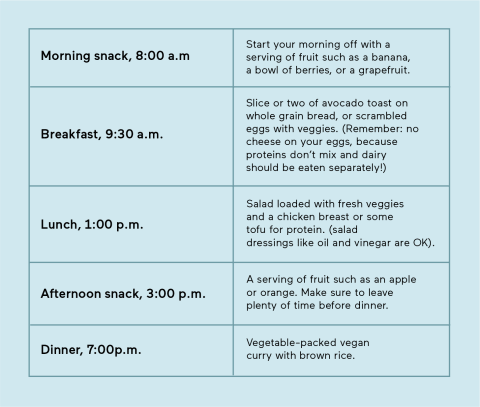These are just a few questions that the principles of “food combining” aim to answer. Here, we dig into whether or not this Ayurveda-inspired way of eating has real perks, plus how to do it. The basic concept of food combining was then revived in the 1920s through the Hay Diet. The Hay diet was formulated by the New York-based physician William Howard Hay and classifies foods as acid, alkaline, or neutral. He believed that the proper combination of these foods was the solution to improved health. For example, one of Dr. Hay’s rules is that carbs should not be eaten at the same meal as fruits or protein, but should be eaten with neutral foods like fats. Skip forward to today, and the food combining diet has made another comeback on Pinterest, with loads of bloggers and influencers sharing their food combining charts and simple recipes. The modern food combining diet seems to be a hybrid of both the Hay Diet and the traditional eating practices of Ayurveda. Second, it is believed that different foods are broken down more efficiently at different levels of acidity (aka pH levels) in your body. So the reason that starches can be eaten with non-starchy vegetables is that both of these foods can be digested at the same pH level, and starches and protein shouldn’t be eaten together because they require different pH levels for digestion. For example, many registered dietitians recommend eating fruits with protein and/or fat to help balance the rise in blood sugar. This is especially important for people with diabetes. Eating fruit with protein or fat helps make that snack more satiating as well. I don’t know anyone who’s felt full after eating just grapes! Additionally, the rules of food combining diets focus on pairing foods with compatible pH levels to make digestion more efficient. But basic biochemistry shows that the body has its own methods to handle the differing pH levels of foods and ensure appropriate digestion. Digestion begins in the mouth, for starches, and then continues in the stomach. The stomach is an acidic environment due to hydrochloric acid. No matter what you eat, food in the stomach will be acidic. Some proteins are able to be digested in the stomach, but most digestion and absorption happens in the small intestine. The acidic, partially broken down food from the stomach then travels to the small intestine. Once the food enters the small intestine, a hormone called secretin that stimulates the release of pancreatic bicarbonate to make the small intestine more alkaline and less acidic. Most nutrients best absorbed in this less acidic environment. Food combining is a way of eating that has been around for thousands of years, and although scientific evidence supporting this diet is lacking, it doesn’t mean it’s not beneficial. The principles of food combining found in Ayurveda are not based on biochemistry, but rather spirituality. Traditional Ayurvedic diets also place a high emphasis on mindfulness when eating. Eating foods in the separate groups, as you would with food combining, may help you think through your food choices and how much of a food you are putting in your body. Additionally, the rules of food combining don’t always allow for a lot of variety in the diet. Some studies have shown that having more variety in the types of food you eat can cause increased consumption at that meal, and having less variety of foods at meals could help reduce energy intake and promote weight loss1. However, that’s not necessarily a perk, as this decreased variety of foods may also decrease the variety of nutrients you’re consuming.




